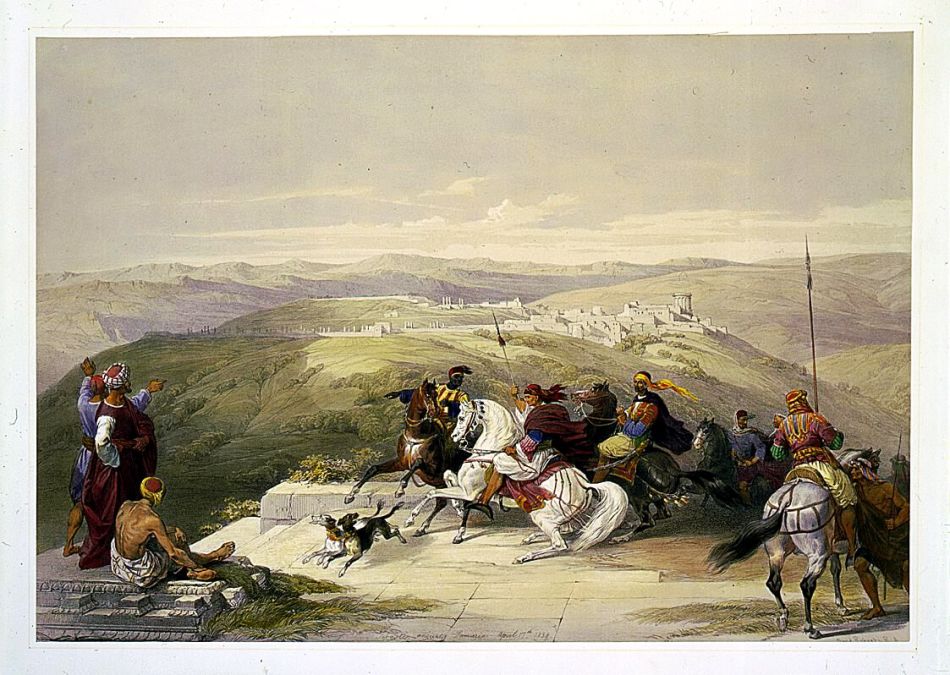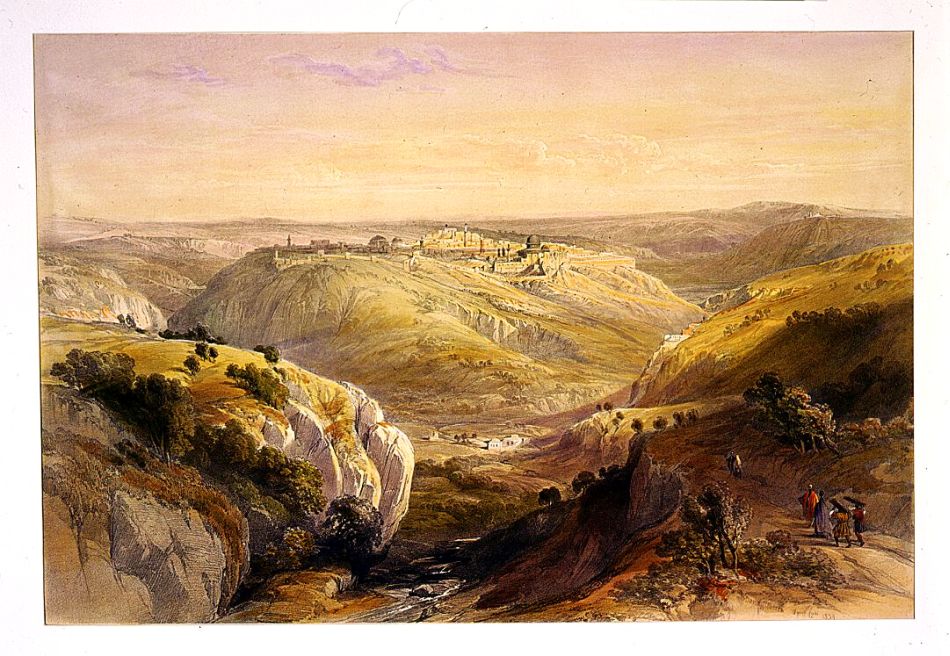DAWN
Daily Arts Web Nucleus
Discover the Arts! Each day a different image from the Literary, Performing, or Visual Arts representing a portion of Scripture plus an explanation with links 2016 March 23
Image 1: Sebast (Ancient Samaria) - (1839)
Art by David Roberts (1796-1864), and Lithography by Louis Haghe (1806-1885)
Orientalism Style of Academic Art
Contained in the Books The Holy Land, Syria, Idumea, Arabia, Egypt and Nubia (1842-1846), and Egypt and Nubia (1846-1849)
Image Source: OldBookArt.com
~~~~~~~~~~
Image 2: Jerusalem from the South (1839)
Art by David Roberts (1796-1864), and Lithography by Louis Haghe (1806-1885)
Orientalism Style of Academic Art
Contained in the Books The Holy Land, Syria, Idumea, Arabia, Egypt and Nubia (1842-1846), and Egypt and Nubia (1846-1849)
Image Source: OldBookArt.com
Explanation: In Micah 1 the LORD announces widespread destruction in many places including Jerusalem and Samaria, which are the capital cities of Judah and Israel, respectively. In Israel, in particular, cities will be destroyed, idols will be broken, the land will be desolate, and people will go into captivity.
Background Summary: Micah (737-690 B.C.) prophesied in the reigns of the Judean kings Jotham (750-731 B.C.), Ahaz (735-715 B.C.), and Hezekiah (715-686 B.C.). He was a contemporary of Hosea (760-720 B.C.) and Isaiah (740-681 B.C.). He was also a contemporary of Israel's last two kings Pekah (752-732) and Hoshea (732-722).
The Following is a quote from the JFB Commentary: "Micah was a native of Moresheth, not the same as Mareshah in Mic_1:15, but the town called Moresheth-gath (Mic_1:14), which lay near Eleutheropolis, west of Jerusalem, on the border of the Philistine country; so called to distinguish it from Moresheth of Judah. His full name is Micaiah (not the Micaiah mentioned 1 Ki_22:8, the son of Imlah), signifying, Who is like Jehovah? The time of his prophesying is stated in the introduction to be in the reigns of Jotham, Ahaz, and Hezekiah, that is, between 757 and 699 b.c. Jeremiah (Jer_26:18) quotes Mic_3:12, as delivered in the reign of Hezekiah. He was thus a contemporary of Isaiah and Hosea. The idolatries practiced in the reign of Ahaz accord with Micah's denunciations of such gross evils, and confirm the truth of the time assigned Mic_1:1. His prophecies are partly against Israel (Samaria), partly against Judah. As Samaria, Israel's metropolis, was taken first, and Jerusalem, the capital of Judah subsequently, in the introductory heading, Mic_1:1, Samaria is put first, then Jerusalem. He prophesies the capture of both; the Jews' captivity and restoration; and the coming and reign of Messiah. His style is full, round, and perspicuous; his diction pure, and his parallelisms regular. His description of Jehovah (Mic_7:18, Mic_7:19) is not surpassed by any elsewhere in Scripture. The similarity between Isaiah and Micah in some passages (compare Mic_4:1-3, with Isa_2:2-4) is to be accounted for by their being contemporaries, acquainted with each other's inspired writings, and having the same subjects for their theme. Hengstenberg maintains that the passage in Micah is the original. Isaiah was somewhat the older, being a prophet in the reign of Uzziah [790-740 B.C.], Jotham's predecessor, whereas Micah began his prophecies under Jotham."
[ Sermons: Dominic Smart. William Still. ].
Today's images are of Samaria and Jerusalem, the cities mentioned in today's chapter.
THEMATICALLY AND CHRONOLOGICALLY RELATED SCRIPTURES: JOTHAM: 2 Kings 15; 2 Chronicles 26:21-23; 2 Chronicles 27:1-9. AHAZ: 2 Kings 15:38; 2 Kings 16; 2 Kings 17:1; 2 Chronicles 27:9; 2 Chronicles 28. HEZEKIAH: 2 Kings 16:20; 2 Kings 18-20; 2 Chronicles 28:27; 2 Chronicles 29-32. Jeremiah 26:18-19. PEKAH: 2 Kings 15:25-37; 2 Kings 16:1-5; 2 Chronicles 28:6; Isaiah 7:1. HOSHEA: 2 Kings 15:30; 2 Kings 17; 2 Kings 18:1-12. ]
[ CHRONOLOGY: GENERAL. Patriarchs (Traditional). Judges # 1. Judges # 2. Kings # 1. Kings # 2. Prophets # 1. Prophets # 2. NT # 1. NT # 2. NT # 3. ]
[ MAPS: Maps # 1. Maps # 2. Maps # 3. Maps # 4. Maps # 5. ]
[ COMMENTARIES, ETC: GENERAL: Bible Study Tools; Bible Hub: Study Light; Blue Letter Bible // PSALMS: Monergism: Precept Austin: The Treasury of David; John Gill; John Calvin - Volumes 1, 2, 3, 4, 5]
[ MUSIC: GENERAL: The Cyber Hymnal // PSALMS: Genevan Psalter (Instrumental). VARIOUS ARTISTS: Micha'el Ben David. Sons of Korah. Fernando Ortega. Janet Isaac Morrison. Music of the Bible Revealed - Suzanne Haik-Vantoura. Dr. David Erb. Gregorian Chants. ]
1. Judgment & Blessing: Cycle 1 (1:1 - 2:13) - 737 - 690 B.C., Israel
2. Judgment & Blessing: Cycle 2 (3:1 - 5:15) - 737 - 690 B.C., Israel
3. Judgment & Blessing: Cycle 3 (6:1 - 7:20) - 737 - 690 B.C., Israel
Micah 1
1. Judgment & Blessing: Cycle 1 (1:1 - 2:13) - 737 - 690 B.C., Israel
A. Judgments on Israel and Judah (1:1 - 2:11)
1 The word of the LORD that came to Micah the Morasthite in the days of Jotham, Ahaz, and Hezekiah, kings of Judah, which he saw concerning Samaria and Jerusalem.
2 Hear, all ye people; hearken, O earth, and all that therein is: and let the Lord GOD be witness against you, the Lord from his holy temple.
3 For, behold, the LORD cometh forth out of his place, and will come down, and tread upon the high places of the earth.
4 And the mountains shall be molten under him, and the valleys shall be cleft, as wax before the fire, and as the waters that are poured down a steep place.
5 For the transgression of Jacob is all this, and for the sins of the house of Israel. What is the transgression of Jacob? is it not Samaria? and what are the high places of Judah? are they not Jerusalem?
6 Therefore I will make Samaria as an heap of the field, and as plantings of a vineyard: and I will pour down the stones thereof into the valley, and I will discover the foundations thereof.
7 And all the graven images thereof shall be beaten to pieces, and all the hires thereof shall be burned with the fire, and all the idols thereof will I lay desolate: for she gathered it of the hire of an harlot, and they shall return to the hire of an harlot.
8 Therefore I will wail and howl, I will go stripped and naked: I will make a wailing like the dragons, and mourning as the owls [daughters of an owl/ostrich].
9 For her wound is incurable; for it is come unto Judah; he is come unto the gate of my people, even to Jerusalem.
10 Declare ye it not at Gath, weep ye not at all: in the house of Aphrah roll thyself in the dust.
11 Pass ye away, thou inhabitant of Saphir, having thy shame naked: the inhabitant of Zaanan came not forth in the mourning of Bethezel; he shall receive of you his standing.
12 For the inhabitant of Maroth waited carefully for good: but evil came down from the LORD unto the gate of Jerusalem.
13 O thou inhabitant of Lachish, bind the chariot to the swift beast: she is the beginning of the sin to the daughter of Zion: for the transgressions of Israel were found in thee.
14 Therefore shalt thou give presents to Moreshethgath: the houses of Achzib shall be a lie to the kings of Israel.
15 Yet will I bring an heir unto thee, O inhabitant of Mareshah: he shall come unto Adullam the glory of Israel.
16 Make thee bald, and poll thee for thy delicate children; enlarge thy baldness as the eagle; for they are gone into captivity from thee.
ADDITIONAL AD LIB MATERIAL: Prose, Poetry, Writers, Visual Artists, Music, DAWN, and ILLUMINATION. ILLUMINATION features a compact, Illuminated Bible. DAWN, the page you are presently visiting, features a new image and explanation daily.
Please Email Comments and Questions To
AD LIB ARTS EMAIL
copyright 2014, Scott Souza
|

